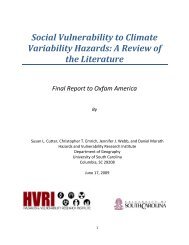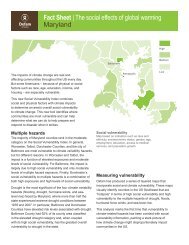Poverty Footprint Study on how the Coca Cola - Oxfam America
Poverty Footprint Study on how the Coca Cola - Oxfam America
Poverty Footprint Study on how the Coca Cola - Oxfam America
You also want an ePaper? Increase the reach of your titles
YUMPU automatically turns print PDFs into web optimized ePapers that Google loves.
Table 12 Water use ratios at SABMiller bottling plants for 2009*<br />
Country Plant Water Ratio<br />
YTD (HL/HL)<br />
Access in Zambia<br />
Water YTD (Hls) Producti<strong>on</strong><br />
Volume YTD (Hls)<br />
Zambia Ndola CSD 12.14 1,087,994 89,600<br />
Zambia Lusaka CSD 5.64 2,197,140 389,535<br />
El Salvador In La C<strong>on</strong>stancia<br />
CSD<br />
El Salvador In La C<strong>on</strong>stancia<br />
Juice and water<br />
CSD = Carb<strong>on</strong>ated Soft Drink<br />
2.62 5,854,733 2,237,168<br />
1.72 4,317,683 2,506,809<br />
Water supplies are abundant in Zambia, and yet as <strong>the</strong> populati<strong>on</strong> and ec<strong>on</strong>omy grow, communities are<br />
increasingly competing for access to this water. For instance, water use in sugar growing has been a source of<br />
tensi<strong>on</strong> over water access. There is increasing competiti<strong>on</strong> between Zambia’s power utility and Zambia Sugar<br />
for water from <strong>the</strong> nearby Kafue River, which is used for hydropower generati<strong>on</strong> and sugarcane irrigati<strong>on</strong> and<br />
by local communities. Owing to <strong>the</strong> <strong>on</strong>going expansi<strong>on</strong> of Zambia Sugar’s growing areas, this competiti<strong>on</strong> is<br />
growing more intense.<br />
SABMiller states that its CSD bottling plants in Zambia use from 5.64 to 12.14 hectoliters of water to produce<br />
1 hectoliter of <strong>Coca</strong>-<strong>Cola</strong> products. In El Salvador, this ratio is as low as 1.72 for water and juices and 2.62 for<br />
carb<strong>on</strong>ated soft drinks.<br />
SABMiller Water Strategy<br />
Water represents a significant risk to parts of our business, as well as to some of <strong>the</strong> communities in which<br />
we operate. We also know that issues of scarcity and accessibility cross community and nati<strong>on</strong>al boundaries<br />
and involve interdependent factors that can vary from country to country and regi<strong>on</strong> to regi<strong>on</strong>. It follows that<br />
<strong>the</strong> water issue cannot simply be managed within <strong>the</strong> c<strong>on</strong>fines of our own operati<strong>on</strong>s. Local water challenges<br />
are usually best solved in partnership with NGOs, local governments and o<strong>the</strong>r local businesses. In <strong>the</strong><br />
regi<strong>on</strong>s where we operate, we aim to foster a collaborative approach to ensure <strong>the</strong> best outcome both for<br />
our business and for <strong>the</strong> local community. Our water strategy is based <strong>on</strong> <strong>the</strong> 5Rs (pRotect, Reduce, Reuse,<br />
Recycle and Redistribute), a comprehensive, risk-based approach to managing water in our business and<br />
in <strong>the</strong> value chain. This model provides a c<strong>on</strong>sistent approach, recognizing <strong>the</strong> different local issues and<br />
circumstances faced by each of our businesses. Over and above our internal commitment to become 25<br />
percent more water efficient by 2015, SABMIller has established <strong>the</strong> Water Futures partnership, which<br />
includes watershed protecti<strong>on</strong> collaborati<strong>on</strong>s with NGOs and governments across <strong>the</strong> world, including<br />
countries at risk of water scarcity in Africa and in Latin <strong>America</strong>. SABMiller published <strong>the</strong> first corporate water<br />
footprint in partnership with WWF in 2009 and in 2010 extended this fur<strong>the</strong>r to include soft drinks in markets<br />
such as South Africa.<br />
See www.sabmiller.com/water for fur<strong>the</strong>r details.<br />
*Source SABMiller<br />
Exploring <strong>the</strong> links between internati<strong>on</strong>al business and poverty reducti<strong>on</strong> 67




